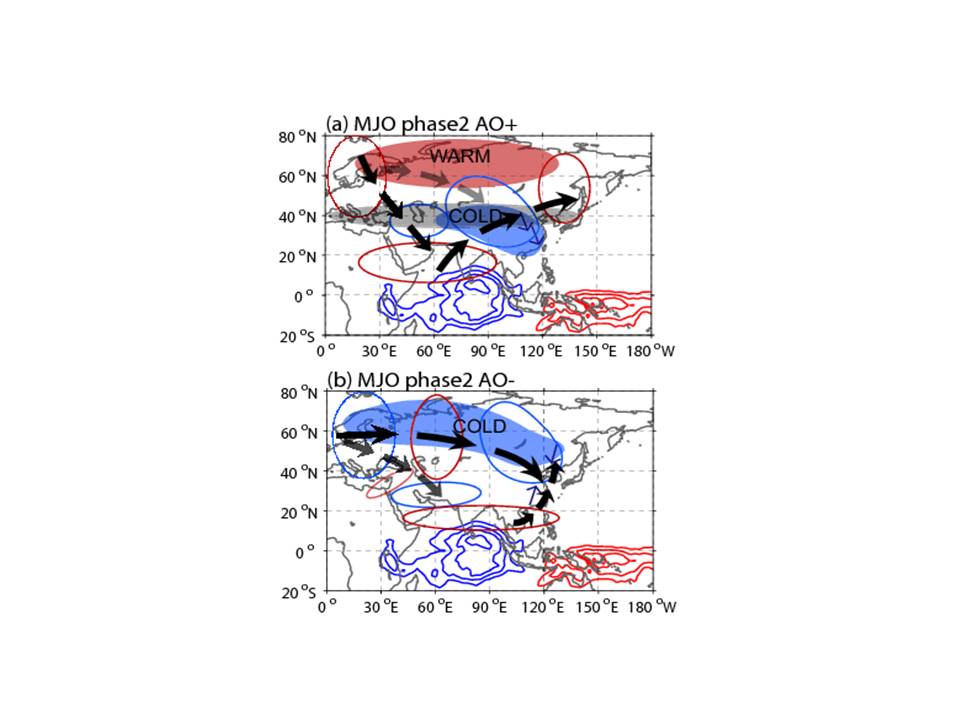State Key Laboratory of Numerical Modeling for Atmospheric Sciences and
Geophysical Fluid Dynamics (LASG)
Institute of Atmospheric Physics, Chinese Academy of Sciences

Vol. 10/No.10 August 2019
Cooperative influences of the MJO and AO on intraseasonal winter temperature variations over East Asia
Highlights: The MJO-related winter temperature anomalies over East Asia differ among positive, neutral, and negative AO phases. These differences are related to cooperation between the AO-induced mid-latitude Rossby wave train and the MJO-induced poleward wave train. Cold events over eastern China can be induced by MJO-associated anomalous convection over the Maritime Continent in association with a negative AO. The relationship between the MJO convection over the tropical Indian Ocean and the cold events over East Asia changes in early and late winter due to the change in the MJO-AO connection.
Summary: Previous studies have indicated that the occurrence of cold events over East Asia is related to both the AO and MJO. Most previous studies considered the impacts of the AO and MJO on cold events over East Asia separately. The cooperative influences of the AO and MJO has rarely been investigated.
A recent study published in Journal of Climate by Dr. SONG Lei and Prof. WU Renguang revealed that the MJO-related temperature anomalies over East Asia have notable differences among positive, neutral, and negative AO phases. In MJO phases 2–3, cold anomalies over eastern China occur mainly during positive AO (Figure 1). In MJO phase 7, warm anomalies over eastern China are observed mostly during neutral AO. In MJO phase 8, warm anomalies appear in positive and neutral AO. The above differences are associated with changes in the cooperation between the AO-related mid-latitude Rossby wave train and the MJO-related poleward wave train.
The MJO-related convection over the Indian Ocean has been linked to the cold anomalies over East Asia by many previous studies. In another recent study published in Journal of Climate, Dr. SONG Lei and Prof. WU Renguang found that winter cold events over eastern China can be induced by the MJO-associated anomalous convection over the Maritime Continent. The Maritime Continent convection-related cold events tend to occur with a negative AO. Anomalous convective heating over the Maritime Continent triggers a poleward Rossby wave train, which, together with an AO-related southward wave train from northern Eurasia, contributes to the cold anomalies. Anomalous tropical heating over the Maritime Continent induces a meridional vertical circulation, with large-scale air mass convergence in the upper midtroposphere and descending of air on the northern branch of the vertical cell over Siberia (Figure 2), which leads to the development of the Siberian high and cold anomalies over eastern China.
The relationship between the MJO convection over the tropical Indian Ocean and the cold events over East Asia differs in early and late winter. Dr. SONG Lei and Prof. WU Renguang detected in another study published in Journal of Geophysical Research: Atmospheres that more than 70% of intraseasonal cold events over eastern China are associated with the MJO phases 2–3 in early winter (November–December), but less than 50% of the cold events are linked to the MJO phases 2–3 in late winter (February–March). This difference is related to a weaker connection between the MJO and AO in late winter than in early winter. The weakened connection between the MJO and AO in late winter is caused by the weakened meridional heat fluxes and their weakened constructive interference with climatological stationary waves and a decrease in the poleward propagation of tropospheric eddy momentum and heat fluxes over the western Pacific.

Figure 1. Schematic diagrams showing the main features of surface temperature anomalies in MJO phase 2 during (a) positive and (b) negative AO. The red and blue contours over the tropical region denote positive and negative OLR anomalies, respectively. The red and blue shadings over the Eurasian continent represent warm and cold surface temperature anomalies, respectively. The thin blue arrows over East Asia indicate anomalous surface wind direction. The red and blue contours over the Eurasian continent denote positive and negative streamfunction anomalies, respectively, at 300 hPa. The bold black and gray arrows indicate strong and weak Rossby wave train fluxes at 300 hPa, respectively. The gray shading along 40°N in (a) denotes the divergence of the eddy momentum flux in positive AO.

Figure 2. Schematic diagrams showing the main features of the Maritime Continent convection-related cold events. The blue shading and the cloud on the lower panel over the tropical region denote the convective heating over the Maritime Continent. The blue shadings on the lower panel over eastern China indicate cold surface temperature anomalies. The red contours on the lower panel over Siberia denote the Siberian high. The black arrows over East Asia indicate surface northerly winds. The upward and downward arrows indicate ascending and descending motion on the southern and northern branches of the vertical circulation, respectively. The black arrows on the upper panel indicate northerly divergent winds anomalies. The red and blue contours over the Eurasian continent on the upper panel denote positive and negative streamfunction anomalies at 300 hPa. The green arrows indicate Rossby wave train fluxes at 300 hPa, respectively.
Citations:
Song, L., and R. Wu, 2019: Combined Effects of the MJO and the Arctic Oscillation on the intraseasonal eastern China winter temperature variations. Journal of Climate, 32(8), 2295-2311, doi:10.1175/JCLI-D-18-0625.1.
Song, L., and R. Wu, 2019: Impacts of MJO convection over the Maritime Continent on eastern China cold temperatures. Journal of Climate, 32(12), 3429-3449, doi:10.1175/JCLI-D-18-0545.1.
Song, L., and R. Wu, 2019: Different cooperation of the Arctic Oscillation and the Madden-Julian Oscillation in the East Asian cold events during early and late winter. Journal of Geophysical Research: Atmospheres, 124(9), 4913-4931, doi:10.1029/2019JD030388.
Web: https://journals.ametsoc.org/doi/full/10.1175/JCLI-D-18-0625.1
Web: https://journals.ametsoc.org/doi/full/10.1175/JCLI-D-18-0545.1
Web: https://agupubs.onlinelibrary.wiley.com/doi/abs/10.1029/2019JD030388
Contact: WU Renguang, renguang@mail.iap.ac.cn
E-mail: lasg_newsletter@lasg.iap.ac.cn
Editors: Chuanyi Wang (wangcy@lasg.iap.ac.cn), Kangjun Chen(ckj@lasg.iap.ac.cn)